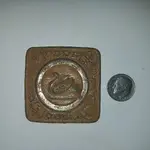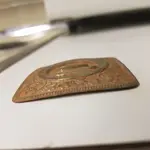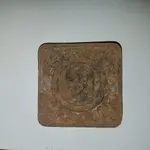You are using an out of date browser. It may not display this or other websites correctly.
You should upgrade or use an alternative browser.
You should upgrade or use an alternative browser.
I need help to identify this artifact
- Thread starter STUDEM
- Start date
- Joined
- May 28, 2010
- Messages
- 20,329
- Reaction score
- 32,313
- Golden Thread
- 1
- Location
- White Plains, New York
- 🥇 Banner finds
- 1
- 🏆 Honorable Mentions:
- 1
- Detector(s) used
- Nokta Makro Legend// Pulsedive// Minelab GPZ 7000// Vanquish 540// Minelab Pro Find 35// Dune Kraken Sandscoop// Grave Digger Tools Tombstone shovel & Sidekick digger// Bunk's Hermit Pick
- Primary Interest:
- Metal Detecting
Maybe the top to a cosmetic compact.

Keith Jackson
Hero Member
From the pictures provided, I can't see any type of hinge. A picture of the back would help.
ffazis
Tenderfoot
- Joined
- Jul 9, 2018
- Messages
- 1
- Reaction score
- 0
- Golden Thread
- 0
- Primary Interest:
- All Treasure Hunting
I found an artifact at my grandpa's property. I was sure about its worth and tried to find a way to identify it. The most helpful platform to do that appeared to be publicarcheology.com
Please remember we do not allow links to treasure sites that allows comments on finds, blogs are allowed as long as comments are not allowed.
dognose
Silver Member
Can you give the dimensions and possibly the material its made from? Is it heavy? Any rusting? Patina?
It could be a part of a light fixture where like panel were on the column.
It could be a part of a light fixture where like panel were on the column.
War Reconstructionist
Jr. Member
- Joined
- May 16, 2018
- Messages
- 21
- Reaction score
- 36
- Golden Thread
- 0
- Location
- Richmond, VA
- Detector(s) used
- XP Deus, Nautilus, Garrett, Carrot, Mi-6
- Primary Interest:
- All Treasure Hunting
Possibly a Tin lid from Swan, may want to check it out.
Swan Filter Tips and Rolling Papers
Swan is a well established brand within the rolling tobacco market. Originally formed in 1883 they were well known for their Matches which tended to burn better in the open air and are branded under Swan Vestas Matches which are reputably the best selling matches in the UK. Swan are also well know for high quality filter tips which are available from ultra slims to standard filter tips giving the user a wide choice of filter tips to use. They also do a range of rolling papers as well as lighters.
Swan Filter Tips and Rolling Papers
Swan is a well established brand within the rolling tobacco market. Originally formed in 1883 they were well known for their Matches which tended to burn better in the open air and are branded under Swan Vestas Matches which are reputably the best selling matches in the UK. Swan are also well know for high quality filter tips which are available from ultra slims to standard filter tips giving the user a wide choice of filter tips to use. They also do a range of rolling papers as well as lighters.
STUDEM
Greenie
- Joined
- Jul 7, 2018
- Messages
- 10
- Reaction score
- 4
- Golden Thread
- 0
- Primary Interest:
- All Treasure Hunting
- #12
Thread Owner
The object is 2 inches long on each side and appears to be made out of stamped/pressed tin. It is very light and thin with a small curvature. There is some rust and no patina. I have seen another one with some patina on the oject.
I am pretty sure the artifact dates back to the mid-late 1800's.
I am pretty sure the artifact dates back to the mid-late 1800's.
Miranda1
Tenderfoot
- Joined
- Apr 17, 2018
- Messages
- 2
- Reaction score
- 0
- Golden Thread
- 0
- Primary Interest:
- All Treasure Hunting
Cerambycidae, longhorned beetle, longicorns, capricorns, round-headed borers, timber beetles, goat beetles (bock-käfern), or sawyer beetles, Most adult cerambycids, particularly the brightly colored ones, feed on flowers but there are many spieces so i will have to take some time to look thru all the photo till i find it wish me luck.
see site
next time please state their size and area found, for Across the U.S. and Canada, they vary from (size)3mm to 60 mm
and About 1000 species occur in the US and Canada(many others all over the world, with over 20,000 species )
PS : they have wings under their wing cover. The adults are common visitors to flowers, feeding on pollen or nectar. The larvae feed on the moist dead wood of various trees and various human artifacts, the latter including wooden poles, cross-ties, and fences that are not treated with insect-resistant chemicals.May be try to find a site in your bedroom for it young HA HA HA!!!
see site
next time please state their size and area found, for Across the U.S. and Canada, they vary from (size)3mm to 60 mm
and About 1000 species occur in the US and Canada(many others all over the world, with over 20,000 species )
PS : they have wings under their wing cover. The adults are common visitors to flowers, feeding on pollen or nectar. The larvae feed on the moist dead wood of various trees and various human artifacts, the latter including wooden poles, cross-ties, and fences that are not treated with insect-resistant chemicals.May be try to find a site in your bedroom for it young HA HA HA!!!
- Joined
- Dec 30, 2012
- Messages
- 10,240
- Reaction score
- 19,444
- Golden Thread
- 0
- Location
- Canton Ohio Area
- 🏆 Honorable Mentions:
- 2
- Detector(s) used
- Presently using Deus 2's & have Minelabs, Nokta's Tesoro's DEus's Have them all . Have WAY to many need to get rid of some
- Primary Interest:
- All Treasure Hunting
I am voting for something Terry S is thinking. Maybe the top of a snuff canister ?
Last edited:
Similar threads
- Replies
- 15
- Views
- 568
- Replies
- 1
- Views
- 163
Users who are viewing this thread
Total: 1 (members: 0, guests: 1)






